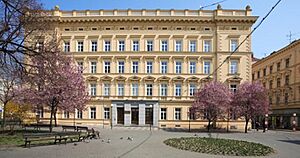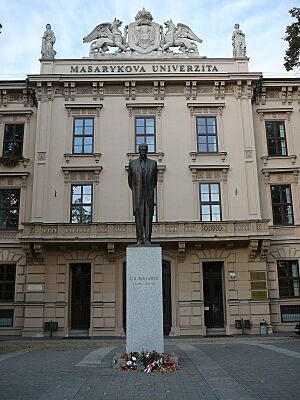Masaryk University facts for kids
|
Masarykova univerzita
|
|
 |
|
| Latin: Universitas Masarykiana Brunensis | |
| Type | Public |
|---|---|
| Established | 1919 |
| Rector | Prof. Martin Bareš |
|
Academic staff
|
2,200 |
|
Administrative staff
|
3,000 |
| Students | 35,115 |
| Location |
,
49°11′55″N 16°36′18″E / 49.19861°N 16.60500°E |
| Campus | Urban |
| Colors | Blue |
| Affiliations | EUA Compostela Group Utrecht Network |
 |
|
Masaryk University (often called MU) is a big university in the Czech Republic. It's the second largest in the country! It was started in 1919 in a city called Brno. Today, it has ten different schools, called faculties, and more than 35,000 students.
The university is named after Tomáš Garrigue Masaryk. He was the very first president of an independent Czechoslovakia. He also worked hard to create a second Czech university. In 1960, the university's name was changed for a while. But in 1990, after a big change in the country (the Velvet Revolution), it got its original name back. Since 1922, over 171,000 students have graduated from Masaryk University.
Contents
History of Masaryk University
How the University Started
Masaryk University opened its doors on January 28, 1919. It began with four main schools: Law, Medicine, Science, and Arts. Tomáš Garrigue Masaryk, who later became the first president of Czechoslovakia, played a huge role in making this university happen. He believed it was important to have more than one Czech university to encourage new ideas and competition in science.
Starting a second Czech university was only possible after the Austro-Hungarian government ended. Before that, the city council in Brno, which was controlled by Germans, didn't want a new university. They worried it would give more power to the Czech people living in Brno. Brno was a city where both Czech and German languages were spoken. In 1905, many people even held a big protest to show they wanted a university in Brno.
Challenges and Changes Over Time
From the very beginning, the university didn't have a lot of money. Because of money problems in the 1920s and 1930s, there were ideas to close the Arts and Science schools. Luckily, both schools stayed open.
However, on November 17, 1939, the entire university was closed. This happened after Germany took over Czechoslovakia. Many professors from Masaryk University faced harsh treatment; for example, the Faculty of Science lost a quarter of its teachers.
| Faculty | Year founded |
| Faculty of Medicine | 1919 |
| Faculty of Law | 1919 |
| Faculty of Science | 1919 |
| Faculty of Arts | 1919 |
| Faculty of Education | 1946 |
| Pharmaceutical Faculty | 1952* |
| Faculty of Economics and Administration | 1991 |
| Faculty of Informatics | 1994 |
| Faculty of Social Studies | 1998 |
| Faculty of Sports Studies | 2002 |
| * Pharmaceutical Faculty was closed down in 1960 and then later renewed in 2020 | |
After World War II ended, university life started to get back to normal. But then, the country went through a big political change. This led to many students being expelled from different schools. For example, almost half of the students at the Faculty of Law were expelled, and that school was completely closed in 1950. In 1953, the Faculty of Education became a separate school. In 1960, the Pharmaceutical Faculty was closed, and the university's name was changed to Jan Evangelista Purkyně University in Brno.
Things got a bit better in 1964 when the Faculty of Education rejoined the university. The Faculty of Law also reopened in 1969. But then, in the 1970s, after foreign troops entered Czechoslovakia, conditions changed again.
Modern Era and Growth
The university got its original name, Masaryk University in Brno, back in 1990. In 2006, they even dropped "in Brno" from the name. A new period of growth began after the Velvet Revolution in 1989. Many new schools were added:
- Faculty of Economics and Administration (1991)
- Faculty of Informatics (1994)
- Faculty of Social Studies (1998)
- Faculty of Sports Studies (2002)
A brand new university campus has been built in Brno-Bohunice since 2002. This campus is home to most of the Faculty of Medicine, Faculty of Sports Studies, and part of the Faculty of Sciences. It also has important research centers like the Central European Institute of Technology.
In 2013, the university started running the University Cinema Scala. This used to be a movie theater that had been around for over 80 years! Now, it's used for university events, lectures, and conferences, as well as showing movies.
Faculties: What You Can Study
Masaryk University has ten different faculties, which are like specialized schools. Here's a look at what each one offers:
Original Faculties (Founded 1919)
- Faculty of Law (PrF): This is one of the oldest schools. It teaches students about laws and how the government works. You can study to become a lawyer or work in public administration.
- Faculty of Medicine (LF): This school trains future doctors and dentists. It works closely with hospitals in Brno. Students learn about general medicine, dentistry, nursing, and other health fields.
- Faculty of Science (PřF): Here, you can explore subjects like biology, chemistry, physics, math, geography, and geology. It's for students who love to understand how the natural world works.
- Faculty of Arts (FF): This is the biggest faculty at the university. It offers many programs in languages, literature, history, philosophy, psychology, and different art forms.
Newer Faculties
- Faculty of Education (PdF): Started in 1946, this faculty trains future teachers. You can study to teach humanities, sciences, or arts subjects.
- Faculty of Pharmacy (FaF): This school teaches about medicines and how they work. It was first open from 1952 to 1960 and then reopened in 2020.
- Faculty of Economics and Administration (ESF): Established in 1990, this faculty focuses on business, money, and how to manage organizations.
- Faculty of Informatics (FI): Created in 1994, this school is all about computers and technology. You can study informatics and how to apply it in different areas.
- Faculty of Social Studies (FSS): This faculty, which became independent in 1998, studies how people interact in society. It covers topics like media, social policy, and international relations.
- Faculty of Sports Studies (FSpS): The newest faculty, started in 2002, is for students interested in sports. It covers everything from athletics and swimming to sports management and teaching sports.
Academics and Research
Education at MU
As of 2014, Masaryk University has over 35,000 students and more than 2,200 teachers. It offers many different study programs:
- Over 200 bachelor's degree programs
- 290 master's degree programs
- 130 doctoral (Ph.D.) programs
Some of these programs are taught in English or German. The university also helps international students who come to study there. In the 2012/13 school year, over 1,000 international students attended. There's also a special center called Teiresiás that helps students with special needs.
The university opened the Mendel Museum in 2007. This museum celebrates the work of Gregor Mendel, who was a famous scientist. He did important experiments on genetics in the same place where the museum is now. Top scientists from around the world give special talks called the Mendel Lectures at the museum.
The University Cinema Scala has been run by Masaryk University since October 2013. It was the first university cinema in the Czech Republic! Every year, on International Students' Day, a public discussion called the Freedom Lecture is held there.
Research at MU
Masaryk University is very active in research. It works with other institutions on CEITEC. This is a research center that focuses on life sciences.
The university also owns and runs the Mendel Polar Station in Antarctica! This station helps scientists do important research on biology, geology, and climate in Antarctica. It was built in 2005 and 2006 and is used during the Antarctic summers.
The university has an office that helps turn research ideas into real-world products and services. It also helps scientists work with businesses.
Funding for Research
The Grant Agency of Masaryk University (GAMU) helps students and researchers get money for their projects. They offer different types of grants, including:
- Support for preparing international research projects.
- Funding for projects that combine different study areas.
- Awards for excellent research in science and humanities.
- Support for researchers returning to their careers after a break.
- Awards for outstanding research results.
University Rankings
| University rankings | |
|---|---|
| Global – Overall | |
| THE World | 501–600 |
| Regional – Overall | |
| QS Emerging Europe and Central Asia | 7 (2022) |
Masaryk University is known for its strong research. It works a lot with other famous universities and research places around the world. For several years, it has been ranked among the top 600 universities globally. Among universities in EU countries that joined the EU after 2004, Masaryk University was ranked 7th. A recent ranking also placed Masaryk University among the top student cities in the world, sharing fifth place with cities like Berlin and Vienna.
Notable People from Masaryk University
Masaryk University has over 170,000 graduates. Many famous people have studied or taught there.
Scientists
- Jiří Grygar and Luboš Kohoutek (astronomers)
- Otakar Borůvka and František Wolf (mathematicians)
- Leo Eitinger (psychiatrist)
- Miloslav Petrusek (sociologist)
- Renata Laxova (geneticist)
- Jaroslav Malina (anthropologist)
- Josef Augusta (paleontologist) – he worked with an artist to create amazing pictures of prehistoric life.
Politicians and Public Figures
- Petr Nečas (former Prime Minister of the Czech Republic)
- Michal Hašek (former Governor of the South Moravian Region)
- Tomáš Julínek (former Minister of Health)
- Ondřej Liška (leader of the Czech Green Party)
- Jaroslav Šabata (politician, activist for human rights)
- Martin Palouš (Czech Republic's representative to the United Nations)
Artists and Writers
- František Vláčil (film director)
- Milan Uhde (playwright)
- Antonín Tučapský (composer)
- Jan Skácel and Ivan Blatný (poets)
Athletes
- Šárka Kašpárková (athlete)
- Jiří Holík and Josef Augusta (ice hockey players)
Notable Faculty Members
Many important people have also taught at Masaryk University:
- Antonín Bartoněk (linguist)
- Eduard Čech (mathematician)
- Petr Horálek (astronomer and artist)
- Roman Jakobson (linguist and literary theorist)
- Jaroslav Krejčí (lawyer and former Prime Minister)
- Albert Kutal (art historian)
- Matyáš Lerch (mathematician)
- Zdeněk Měřínský (archeologist)
- Arne Novák (literary historian)
- Bohuslav Sobotka (lawyer and former Prime Minister)
- Tomáš Špidlík (cardinal and theologian)
- František Vláčil (film director)
See also
 In Spanish: Universidad Masaryk para niños
In Spanish: Universidad Masaryk para niños
- List of modern universities in Europe (1801–1945)
- List of Czech universities
- Jan Špaček




